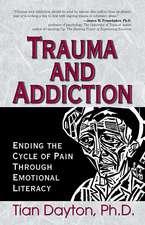Molecular Mechanisms of Dementia: Contemporary Neuroscience
Editat de Wilma Wasco, Rudolph Tanzien Limba Engleză Hardback – noi 1996
| Toate formatele și edițiile | Preț | Express |
|---|---|---|
| Paperback (1) | 785.04 lei 6-8 săpt. | |
| Humana Press Inc. – 21 mar 2013 | 785.04 lei 6-8 săpt. | |
| Hardback (1) | 1117.46 lei 6-8 săpt. | |
| Humana Press Inc. – noi 1996 | 1117.46 lei 6-8 săpt. |
Din seria Contemporary Neuroscience
- 5%
 Preț: 1128.63 lei
Preț: 1128.63 lei - 18%
 Preț: 965.52 lei
Preț: 965.52 lei - 5%
 Preț: 1108.35 lei
Preț: 1108.35 lei - 18%
 Preț: 1228.15 lei
Preț: 1228.15 lei - 18%
 Preț: 1229.73 lei
Preț: 1229.73 lei - 18%
 Preț: 1231.64 lei
Preț: 1231.64 lei - 18%
 Preț: 945.47 lei
Preț: 945.47 lei - 18%
 Preț: 1244.08 lei
Preț: 1244.08 lei - 15%
 Preț: 638.76 lei
Preț: 638.76 lei - 18%
 Preț: 1240.47 lei
Preț: 1240.47 lei - 18%
 Preț: 1385.99 lei
Preț: 1385.99 lei - 18%
 Preț: 1227.84 lei
Preț: 1227.84 lei - 18%
 Preț: 1220.88 lei
Preț: 1220.88 lei - 18%
 Preț: 961.55 lei
Preț: 961.55 lei - 15%
 Preț: 695.70 lei
Preț: 695.70 lei - 18%
 Preț: 959.82 lei
Preț: 959.82 lei - 5%
 Preț: 1112.17 lei
Preț: 1112.17 lei - 18%
 Preț: 1233.83 lei
Preț: 1233.83 lei - 18%
 Preț: 950.96 lei
Preț: 950.96 lei - 24%
 Preț: 799.49 lei
Preț: 799.49 lei - 18%
 Preț: 954.77 lei
Preț: 954.77 lei - 18%
 Preț: 1227.21 lei
Preț: 1227.21 lei - 18%
 Preț: 1248.02 lei
Preț: 1248.02 lei - 18%
 Preț: 949.10 lei
Preț: 949.10 lei - 5%
 Preț: 1114.35 lei
Preț: 1114.35 lei - 15%
 Preț: 694.22 lei
Preț: 694.22 lei - 18%
 Preț: 950.52 lei
Preț: 950.52 lei - 5%
 Preț: 1124.07 lei
Preț: 1124.07 lei - 5%
 Preț: 1117.10 lei
Preț: 1117.10 lei - 24%
 Preț: 1089.43 lei
Preț: 1089.43 lei - 18%
 Preț: 1227.52 lei
Preț: 1227.52 lei - 18%
 Preț: 955.08 lei
Preț: 955.08 lei - 5%
 Preț: 1417.38 lei
Preț: 1417.38 lei
Preț: 1117.46 lei
Preț vechi: 1176.27 lei
-5% Nou
Puncte Express: 1676
Preț estimativ în valută:
213.82€ • 223.85$ • 176.93£
213.82€ • 223.85$ • 176.93£
Carte tipărită la comandă
Livrare economică 05-19 aprilie
Preluare comenzi: 021 569.72.76
Specificații
ISBN-13: 9780896033719
ISBN-10: 0896033716
Pagini: 312
Ilustrații: XI, 312 p. 35 illus., 2 illus. in color.
Dimensiuni: 178 x 254 x 23 mm
Greutate: 0.99 kg
Ediția:1997
Editura: Humana Press Inc.
Colecția Humana
Seria Contemporary Neuroscience
Locul publicării:Totowa, NJ, United States
ISBN-10: 0896033716
Pagini: 312
Ilustrații: XI, 312 p. 35 illus., 2 illus. in color.
Dimensiuni: 178 x 254 x 23 mm
Greutate: 0.99 kg
Ediția:1997
Editura: Humana Press Inc.
Colecția Humana
Seria Contemporary Neuroscience
Locul publicării:Totowa, NJ, United States
Public țintă
Professional/practitionerCuprins
1 Etiological Clues from Gene Defects Causing Early Onset Familial Alzheimer’s Disease.- 2 Potential Biological Mechanisms of ApoE in Alzheimer’s Disease.- 3 Understanding the Biology and Molecular Pathogensis of Alzheimer’s Disease in Transgenic Mice Expressing Amyloid Precursor Proteins.- 4 Mechanism for ?-Amyloid Overproduction in Alzheimer Disease: Possible Antisense RNA-Mediated Generation of a 5?-Truncated?APP mRNA Encoding 12-kDa C-Terminal Fragment of ?APP, the Immediate Precursor of A?.- 5 Apoptosis and Alzheimer’s Disease.- 6 The ?-Amyloid Model of Alzheimer’s Disease: Conformation Change, Receptor Cross-Linking, and the Initiation of Apoptosis.- 7 Energy/Glucose Metabolism in Neurodegenerative Diseases.- 8 Calcium Homeostasis and Free Radical Metabolism as Convergence Points in the Pathophysiology of Dementia.- 9 ?-Amyloid-Derived Free Radical Oxidation: A Fundamental Process in Alzheimer’s Disease.- 10 Inflammatory Pathways: Implications in Alzheimer’s Disease.- 11 Inflammatory Mediators in Alzheimer’s Disease.- 12 ? Protein and the Neurofibrillary Pathology of Alzheimer’s Disease.- 13 Anatomy of Pathological Alterations in Alzheimer’s Disease.- 14 Cerebral Zinc Metabolism in Alzheimer’s Disease.- 15 Potassium Channels and Calcium Release: Pat ho physiological and Diagnostic Implications for Alzheimer’s Disease.- 16 Pick Disease.- 17 Ischemia.- 18 Prion Diseases and Dementia.
Recenzii
In conclusion, the first chapters of this book provide a lot of very recent information related to the production and the toxicity of the amyloid peptide as well as to the possible role of new genes involved in Alzheimer's disease. It represents a very interesting review for scientists studying the cellular and molecular mechanisms involved in the neurodegeneration of Alzheimer's disease.-ACTA Neurologica Belgica
"The text is logically organized, which helps in making a transition from one subject to the other. The topics are well selected; classical, and new, often controversial, research is covered. Each chapter is succinct and ends with an informative summary...this expertly written overview also provides directions for future studies...a valuable reference and source of inspiration. It is highly recommended to all interested in the molecular basis of neurodegenerative diseases."-Cell Biology International
"The text is logically organized, which helps in making a transition from one subject to the other. The topics are well selected; classical, and new, often controversial, research is covered. Each chapter is succinct and ends with an informative summary...this expertly written overview also provides directions for future studies...a valuable reference and source of inspiration. It is highly recommended to all interested in the molecular basis of neurodegenerative diseases."-Cell Biology International
Textul de pe ultima copertă
Wilma Wasco and Rudolph Tanzi bring together in Molecular Mechanisms of Dementia the best and latest thinking by leading scientists on the etiologic and pathogenic events responsible for the onset of Alzheimer's disease and related dementias. In presenting the various mechanisms and multifaceted approaches currently being employed, the distinguished contributors review such critical factors as apoptosis, energy metabolism, excitotoxicity and calcium-mediated cell death, free radicals, electrophysiological abnormalities, environmental toxins, degeneration of neural networks, and modification of the cytoskeleton. They also examine mechanisms by which ischemia and hypoxia result in dementia.
Molecular Mechanisms of Dementia is the first major contemporary review of this dramatically advancing field. It provides an invaluable summary of the tremendous progress that has been made in developing testable models of the molecular mechanisms of dementia, as well as critical insights into the necessary direction of future investigations of dementia. The book is certain to become a standard reference for all researchers now working in the field of neurodegenerative disorders.
Molecular Mechanisms of Dementia is the first major contemporary review of this dramatically advancing field. It provides an invaluable summary of the tremendous progress that has been made in developing testable models of the molecular mechanisms of dementia, as well as critical insights into the necessary direction of future investigations of dementia. The book is certain to become a standard reference for all researchers now working in the field of neurodegenerative disorders.











